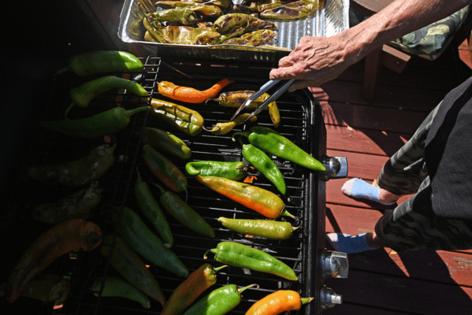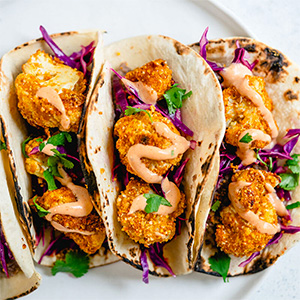As hot as you like: Hatch chile peppers add sizzle of the Southwest to everything
Published in Variety Menu
Cooking creates all kinds of wonderful and comforting smells, whether it's sugar cookies in the oven or a hearty stew on the stovetop. But for me in fall, there's nothing quite like the smoky-sweet scent of Hatch chiles roasting over an open flame or the grates of a hot grill.
The aroma is intoxicating, so intense as it wafts through the air that you can almost taste it. And when you actually lay your hands on peppers that have been so blistered by heat that the skin slips off as easily as a too-big pair of mittens? Expect a rush of endorphins.
The seasonal delicacy adds a kick of flavor to so many different dishes — everything from stews and sauces to tamales, burritos, enchiladas and chile rellenos — it's hard to know where to start.
I first encountered the long and skinny green pepper grown in New Mexico's Hatch Valley during a trip to Santa Fe in 2010 for a food writers conference. After the gathering, my husband and I traveled to Albuquerque to do some hiking and cowboy boot shopping and get our fill of traditional New Mexico cuisine, which is an (often fiery) fusion of Spanish, Native American and Mexican ingredients and techniques.
Mild to spicy red and green chile peppers, including Pueblo, Anaheim and Chimayo chiles, are a defining ingredient in many regional dishes. But Hatch peppers — the term for any chile grown in the Hatch Valley — is by far the most popular variety.
It is the official state vegetable of New Mexico (even though chiles are actually a fruit) and the smoky, mouthwatering smell of them being roasted was designated the state's official aroma in 2023.
As we wandered around the famed Rail Yards Market, we could see why. Our noses quickly caught a whiff of the pod-type chiles being roasted in large steel cylinder cages rotating over an open flame. It takes only a few minutes to char the tough skin and roast the meat inside to a buttery, rich flavor. But the smoky, pop corn-like aroma lingers and lingers.
We heard them, too. The chiles crackle, pop and then hiss as the skin blackens over the sizzling flame and begins to split as water inside the pepper turns to steam.
A signature flavor
Ranked No. 1 in chile production in the U.S., New Mexico grows about 3/4 of the country's chile peppers. In 2023 alone, the state produced some 46,750 tons of Hatch and other chile peppers to the tune of around $41 million in sales. The vast majority — 88%— were harvested green.
Planted in April, Hatch chiles are harvested in August through mid- to late October. Many are picked while they are still immature and bright green but plenty are also allowed to turn red on the vine, which makes them spicier due to a higher concentration of capsaicin.
What makes Hatch chiles so special is the area's unique climate and rich volcanic soil. The Hatch Valley sits so high in the mountains of southern New Mexico that it enjoys hot days, cool nights and lots of sunshine. That imparts the chiles with a distinctive bold and earthy flavor that can't be replicated.
Both red and green chiles can be turned into salsa or a more blended sauce; whether you opt for red or green alone on top of your enchiladas or breakfast burrito, or go "Christmas" with a mix of both, is personal preference.
Locally, you can find New Mexican cuisine made with Hatch chiles at TacoCat on East Ohio Street on the North Side. Along with Hatch red and green salsas, Chef Chris Acosta's menu includes green chile chicken and red chile pork tacos and burritos, and he also offers a green chile burger built with braised pork, egg and pickled veggies.
A Pittsburgher since his teens, Acosta grew up in Phoenix, Ariz., and spent summers at Gil's, the restaurant in a former gas station his grandparents owned in Las Cruces, N.M. Gilbert started working in the fields of Hatch Valley when he was 6 years old so he knew every part of the Hatch chile growing process — from digging up the fields and planting the seeds to helping roast the peppers after harvest.
"That smell to me is wholly intoxicating, of tons of emotion, memory and ancestry, " he says.
So when the COVID-19 pandemic unfolded and he needed reassurance everything would be OK, the chef asked himself: When was I most content?
"That would be a Sunday morning waking up in my grandma's house and smelling that Hatch green chile as part of whatever she was cooking on that back cauldron," he says, "and then her making me huevos con chorizo y papas [eggs with potatoes, chorizo and homemade tortillas]....
"That to me was love. And as we pass on these traditions to Pittsburgh, I think it equates very, very well with pierogies or Primanti Brothers sandwiches. We want to try to make [New Mexican cooking] as iconic as those food offerings here in Pittsburgh."
Since he couldn't find anyone local who was making the foods he'd grown up on, he decided to "package that love in between two corn tortillas," and pass it on to people through New Mexican pop-ups. "Then they would feel that love and hopefully that would change their day," he says.
The Hatch green chile means New Mexico, Acosta says, and New Mexico means hospitality.
"When you arrive in New Mexico, they ask you if you're red or green. That's how devout we are about these chiles.... It's a part of everything we do. It's indigenous, it's deep-rooted. We were doing it before it was America."
While canned and jarred chiles are fairly easy to find in most larger grocery stores, fresh Hatch chiles — which are low in calories and significantly higher in vitamin C than oranges — can be hard to find in Pittsburgh.
Freshly roasted chiles are tougher since Reyna Foods in the Strip District won't be roasting them in a cage this year on Penn Avenue, as it has in the past. (The grocery still has a small selection of frozen Hatch chiles from 2024.)
Cooks who don't mind a drive will find the peppers over the next few weeks at two specialty markets: Fresh Market in Mt. Lebanon ($2.49/pound) and Whole Foods ($4.99 for a 2-pound bag containing 11-13 peppers).
Or follow in the footsteps of my oldest sister, Kathy, who orders a bushel or two of fresh chiles along with bags of flash-frozen, chopped chiles, direct from the Hatch Valley.
My family is of German heritage, but Kathy lived in Denver for nearly 25 years before boomeranging back to Pittsburgh in 2001. She has been roasting and eating Hatch green chiles since her bartending days in the late 1970s, she says, because "they're awesome."
Nothing, in fact, is better in her opinion than digging into a bean burrito smothered in green sauce or wolfing down a Denver "Mexican" burger — a hamburger patty wrapped in a flour tortilla spread with refried beans and topped with green pork chile.
So since moving back East, she's had the peppers shipped to her house in Emsworth each fall, first by friends, then by her son and for the last few years, through Hatch Chile Store.
This year, I asked for her to order me some, too, so I wouldn't have to beg for a Tupperware container of her famed green chile sauce but could instead make it myself. Which is how on a recent Tuesday, I found myself spending the better part of an afternoon helping her roast two huge boxes of mild and medium chiles — 50 pounds in total — on a grill on her deck.
We had originally planned on canning the roasted peppers like you would tomatoes in a hot water bath for easy storage. Then I learned because chile peppers are a low-acid food, they have to be processed in a pressure canner so as to reach the high temperatures required to kill Clostridium botulinum spores. A pressure canner is the one kitchen appliance missing in my pantry because it's scary.
So we took the easy way out and decided to freeze them instead.
How to roast
If you buy frozen Hatch chiles, there's a good chance they will already be cooked, seeded and chopped. If you buy fresh, you'll need to roast them not just to enhance their flavor, but to blister and loosen the pepper's tough skin so they can be peeled.
Chances are you don't have a large, rotating metal drum for charring chiles like you see in the Southwest. Me neither! But no worries — there are multiple ways to roast fresh chiles at home.
You can spear them as you would a marshmallow on a long-handled fork and heat them over a fire, or you can lay them directly on a gas stovetop, rotating them as the skin blisters. You also can place the pods on a baking sheet and stick them under the broiler, turning them frequently, until they're blistered and blackened.
But the easiest method might be my sister's method — fire up your charcoal or gas grill until it's fairly hot, and place the peppers directly on the clean grill grates. Then, using tongs, carefully flip them regularly so the flames/heat hits all sides and they are evenly roasted.
However you proceed, the chiles should be placed in a plastic ziplock bag after they're roasted to steam for a few minutes; once cooled, the skins should slip right off. If you plan on freezing them, don't worry about peeling — the pods will easily peel when you're ready to cook.
Also, be sure to wash each pod thoroughly to remove dirt or debris and pat them dry with a paper towel before beginning to ensure the skin blisters properly.
It wasn't cheap to get our chiles from New Mexico, but considering how many bags we ended up with, it wasn't all that expensive either: It cost $70 per bushel, plus $60 for shipping at hatch-green-chile.com. Another plus: we got to choose our heat level — one mild and one medium (but you also can order hot and extra-hot).
The Hatch Chile Store also sells the chiles already roasted and frozen, whole or chopped. They run from $11.25 to $15 per pound, depending on volume.
Hatch chiles also are available from Young Guns Chile in Hatch, N.M., at www.yghatchchile.com.
Hatch green chiles should be roasted within a few days of purchase. When packed into airtight containers or freezer bags in usable portions and placed in the freezer, they will retain their signature smoky flavor for several months.
They can be used in everything from sauces, appetizers and main courses like tacos and enchiladas to soups, stews and even baked goods.
Below, we offer four recipes that make the most of New Mexico's signature green chile sauce.
Vegetarian Hatch Green Chile Sauce
PG tested
You can use either mild or hot chiles to make this flavorful condiment; if the heat catches your mouth on fire, reach not for water but for something sweet like honey or a bite of sour cream.
To make a chile sauce with meat, brown 1/2 pound ground pork or beef over medium heat in a skillet until all of the pink is gone, and add to the pot with the rest of the ingredients.
4 cups vegetable broth or water
2 cups chopped, roasted Hatch green chile
2 medium tomatoes, chopped
2 teaspoons minced white onion
1 clove garlic
1/2 teaspoon salt
1/4 teaspoon white pepper
2 tablespoons cornstarch, dissolved in 2 tablespoons water
Additional salt and white pepper, to taste
Combine all ingredients except cornstarch in a large saucepan and bring to a boil over medium heat.
Reduce the mixture for 10-15 minutes. Add cornstarch mixture.
Reduce heat to a simmer, and cook for 5-10 minutes. The sauce should be thickened but quite pourable, with no taste of raw cornstarch.
The sauce keeps up to 5 days in the refrigerator, and freezes well. When reheating, add a little extra water if needed.
Makes about 5 cups.
— "The Rancho de Chimayo Cookbook: The Traditional Cooking of New Mexico" by Cheryl and Bill Jamison (Lyons Press, $24.95)
Hatch Green Chile with Pork
PG tested
This hearty, comforting dish is great for topping cheeseburgers for an extra kick of smoky flavor, smothering enchiladas and burritos and, of course, eating right out of the bowl with a warm tortilla for dipping. For a more assertive taste, substitute ground beef for the pork.
2 pounds ground pork
1/2 cup chopped onions, optional
2 cloves garlic, minced
2 tablespoons all-purpose flour
2 14.5-ounces can roasted diced tomatoes
2 pounds chopped, roasted Hatch chiles (about 12 whole)
4 cups water
Salt and freshly ground black pepper, to taste
Shredded Monterey Jack or cheddar cheese or crumbled queso fresco, for garnish
Chopped cilantro, for garnish
In a Dutch oven over medium heat, cook ground pork until it is no longer pink, about 7-8 minutes.
Add onions (if using) and garlic, and saute until the vegetables are soft. Push meat and veggies to the side, and use a fork to mix the flour into the grease in the pan, whisking well to combine.
Add diced tomatoes, chopped green chiles and 4 cups water. Season to taste with salt and pepper. Bring to a boil, then reduce heat.
Simmer chili uncovered for 30-60 minutes, or until thickened to your liking.
Ladle hot stew into bowls. Garnish with shredded cheese and cilantro if desired, and serve with warm flour tortillas for dipping.
Serves 8-10.
— Kathy Trent, Emsworth
Denver's Famous "Mexican" Hamburger
PG tested
This wonderfully messy chile burger features a grilled burger smothered in refried beans, wrapped in a flour tortilla, and topped with pork green chile.
1/2 teaspoon garlic powder
Salt and pepper, or seasoned salt (your choice) to taste
1 pound ground beef
1 1/2 cups warmed refried beans
2 cups shredded Monterey Jack cheese
4 cups green chile sauce
4 10-inch flour tortillas
Shredded lettuce and diced tomatoes, for garnish
Crushed chicharrones, for garnish, optional
Preheat oven's broiler.
Stir garlic powder, salt and pepper into ground beef. Shape into 4 1/4 -pound patties. Set aside until ready to fry.
Heat a cast-iron skillet until hot. Add patties without crowding. Season again and cook for approximately 2 1/2 minutes on each side.
Heat tortillas in a moist paper towel for 45 seconds, then place individually on oven-proof plates. Divide refried beans among the four tortillas.
Top with a burger and add a couple spoonfuls of green chile and shredded cheese. Fold over tortilla.
Cover with 1/2 cup grated cheddar cheese. Place under broiler to melt cheese.
Remove and spoon green chile around entire plate. Take out and garnish with lettuce, tomatoes and crushed chicharrones.
Serves 4.
— Gretchen McKay, Post-Gazette
Huevos Rancheros
PG tested
This vegetarian Mexican breakfast is a hearty regional favorite any time of the day — even dinner. It comes together in minutes and can be served with refried beans and/or Spanish rice to make it a complete meal. So easy!
Vegetable or canola oil, for frying
6 5-inch corn tortillas
12 eggs
2 or 3 cups vegetarian green chile sauce (recipe follows)
Shredded lettuce and chopped tomato, for garnish
Refried beans or Spanish rice, optional sides
Optional garnishes: fresh cilantro leaves, thinly sliced jalapeno pepper and crumbled Cotija cheese
Arrange several layers of paper towels near the stove.
Add oil to a depth of 1/2 inch in a large skillet, and heat until it ripples.
With tongs, dip a tortilla into the hot oil and cook it until it is softened and pliable, a matter of seconds.
Remove tortilla immediately and drain it on the paper towels. (If you don't act quickly, the tortilla will become crisp.)
Repeat with the rest of the tortillas, then pour out of the skillet all but enough oil to generously coat its surface. Reserve the extra oil.
Arrange each tortilla on a plate and set aside.
Place the skillet back on the stove and heat over low heat. Fry the eggs, 2 at a time, turning once the whites have set and the yolk has thickened.
Top each tortilla with two eggs, arranged side by side. Continue until all the eggs are fried, adding a bit of the reserved oil when the skillet becomes dry.
Pour 1/3 or 1/2 cup of green chile sauce over each serving. Garnish plates with lettuce and tomato and other desired toppings.
Serve with scoops of refried beans and Spanish rice, if desired.
Serves 6.
— adapted from "The Rancho de Chimayo Cookbook: The Traditional Cooking of New Mexico"
Smothered Burrito
PG tested
4 7- to 8-inch flour tortillas
4 cups refried beans, warmed
2 cups grated cheddar cheese, plus a little extra for filling, if desired
2 cups green chile sauce (vegetarian or with meat)
1 large tomato, diced
Shredded or chopped lettuce, for garnish
Wrap tortillas in a damp paper towel and microwave them for 30-60 seconds to warm. Or, stack tortillas and wrap tightly in foil, and heat in 300-degree oven for 15-20 minutes.
Set oven to broil.
Assemble burritos: Place a warmed tortilla on a heatproof plate. Spoon about 1 cup refried beans down the center. If you like, add a little cheese.
Roll up the tortilla snugly around the filling, and place it seam side down on the plate. Repeat with remaining tortillas and beans.
Top each burrito with 1/2 cup of the chile sauce and 1/2 cup of cheese. Melt the cheese under the broiler, 1-2 minutes.
Remove from oven and garnish with lettuce and tomatoes.
Serves 4.
— Gretchen McKay, Post-Gazette
©2025 PG Publishing Co. Visit at post-gazette.com. Distributed by Tribune Content Agency, LLC.










Comments